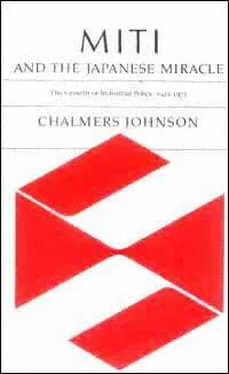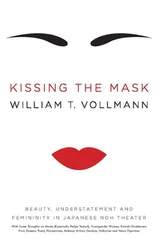Chalmers Johnson - MITI and the Japanese miracle
Здесь есть возможность читать онлайн «Chalmers Johnson - MITI and the Japanese miracle» весь текст электронной книги совершенно бесплатно (целиком полную версию без сокращений). В некоторых случаях можно слушать аудио, скачать через торрент в формате fb2 и присутствует краткое содержание. Год выпуска: 2007, Издательство: Stanford University Press, Жанр: Старинная литература, на английском языке. Описание произведения, (предисловие) а так же отзывы посетителей доступны на портале библиотеки ЛибКат.
- Название:MITI and the Japanese miracle
- Автор:
- Издательство:Stanford University Press
- Жанр:
- Год:2007
- ISBN:нет данных
- Рейтинг книги:3 / 5. Голосов: 1
-
Избранное:Добавить в избранное
- Отзывы:
-
Ваша оценка:
- 60
- 1
- 2
- 3
- 4
- 5
MITI and the Japanese miracle: краткое содержание, описание и аннотация
Предлагаем к чтению аннотацию, описание, краткое содержание или предисловие (зависит от того, что написал сам автор книги «MITI and the Japanese miracle»). Если вы не нашли необходимую информацию о книге — напишите в комментариях, мы постараемся отыскать её.
MITI and the Japanese miracle — читать онлайн бесплатно полную книгу (весь текст) целиком
Ниже представлен текст книги, разбитый по страницам. Система сохранения места последней прочитанной страницы, позволяет с удобством читать онлайн бесплатно книгу «MITI and the Japanese miracle», без необходимости каждый раз заново искать на чём Вы остановились. Поставьте закладку, и сможете в любой момент перейти на страницу, на которой закончили чтение.
Интервал:
Закладка:
8
MITI was engaged on many fronts during this period. The Yawata-Fuji merger, which Sanken and MITI kept totally secret until 1968, required all the influence the ministry could muster to get past the FTC and the other steel companies. MITI also had its difficulties in bringing off mergers in such competitive fields as automobiles and textiles, and the foreigners were not kept quiet for long by the limited liberalization of 1967. However, MITI's abilities to deliver on its policies during the late 1960's were attenuated by internal factional struggles. Sahashi's wrangle with Sumitomo Metals was the true cause of his retirement as vice-minister, but some politicians who wanted him out made a public issue of another incident that they contended showed MITI's arrogance and Sahashi's unsuitability.
As vice-minister, Sahashi had appointed Kawahara Hideyuki (class of 1941) as chief secretary. Kawahara had been one of Sahashi's closest associates for many years and an outstanding MITI official (he was one of the first to identify the pollution problem as serious). On February 27, 1966, Kawahara suddenly took ill and died, and Sahashi authorized a formal, state-financed funeral for him at Tokyo's Tsukiji Honganji (a major Buddhist temple). This led to some petty complaints in the Diet about the small funerals provided for politicians as compared to the elaborate rites for Kawahara. The incident embittered Sahashi but also put the ministry on notice that the politicians were gunning for him and for the type of MITI official he represented.
9
Before his retirement Sahashi was able to name Kawahara's replace-
Page 280
ment as chief secretary, but Minister Miki made it clear that he himself would choose Sahashi's own successor. The next chief secretary was Ojimi * Yoshihisa (March 1966 to May 1968), a transitional figure in that he was sometimes thought of as a member of the "Sahashi faction" (he had headed the Industrial Structure Investigation Office in the Secretariat at the time of the Special Measures Law), but he was also more oriented than Sahashi to the problems of Japan in the world economy. He became the last vice-minister (196971) to have some claim to represent the old "Kishi-Shiina" orientation. For the position of vice-minister after Sahashi, Miki chose Yamamoto Shigenobu, a former chief of the International Trade Bureau and an official who, having served overseas in the Bangkok embassy, was in 1966 director of the Medium and Smaller Enterprises Agency. When Yamamoto took over as vice-minister, he in turn selected Kumagai Yoshifumi as his chief of the Enterprises Bureau, and for the period May 1968 to November 1969 Kumagai succeeded Yamamoto as vice-minister.
In addition to all their pending policy problems, this post-Sahashi team of Yamamoto, Kumagai, and Ojimi had to devote a great deal of attention to the internal problems of factions and lowered morale that had persisted since the Sahashi-Imai fight. By all accounts Yamamoto performed brilliantly; he is one of the most fondly remembered vice-ministers. He set out systematically to put industrial faction officers in international faction posts and vice versa, a policy that also reflected his own background as a specialist in promoting Japan's export trade in heavy machinery and high-value-added products rather than textiles and sundries (he was, significantly, the first vice-minister whose amakudari was to the automobile industry, where he became in 1968 the executive director of Toyota Motors). Typical of Yamamoto's personnel policy was the appointment of Miyazawa Tetsuzo*, who had a background in heavy industry but no overseas service, to be director of the International Trade Bureau; and his appointment of Morozumi Yoshihiko, whose background included service in Paris and the Enterprises Bureau, to be chief of the Mining Bureau.
These policies worked well enough for the time being, but bickering within the ministry continued about Sahashi's policies. Old industrial-policy cadres insinuated that the new leaders were not true "raised-in-the-ministry samurai" (like Sahashi) and that they were inclined to pursue a "foreign appeasement" policy in the face of the demands for capital liberalization. These charges often caused early leaders of the "international faction" to go out of their way to be tough, as for example in the United StatesJapan textile negotiations, in order to refute the accusations that they were predisposed to pla-
Page 281
cate foreigners. After Yamamoto retired and Kumagai became vice-minister, the leaders of the ministry decided that the old Sahashi faction had to go. Kumagai appointed Morozumi chief secretary (May 1968 to November 1969), and he carried out a thorough purge of Sahashi's younger associates. No member of the Sahashi faction prospered in the ministry (with the possible exception of Ojimi *, who was really an independent) after Sahashi himself left the scene.
It is important to understand that this internal factional struggle interacted with and influenced MITI's various policies during this period. The new leaders of the ministry did not differ much from Sahashi on fundamentals, but most of them had served overseas, were well versed in the "culture" of international commerce (which involved institutions such as the IMF, GATT, and the OECD, and trends such as capital liberalization), and they were sensitive to the new, high-technology industries that were shortly to succeed steel, chemicals, and textiles. In contrast to men such as Sahashi, they are accurately described as "cosmopolitan nationalists." They were also the leaders who reformed the ministry in 1973 and who led Japan out of the oil shock.
However, at the time they were establishing their supremacy, they were extremely vulnerable to internal charges that they were caving in to politicians, consorting with foreigners, or otherwise letting down MITI's old traditions. To the extent that they responded to these internal complaints, they left themselves open to external attack from politicians and bureaucrats in other ministries, to charges that they were out of touch with the times, arrogant as the reform bureaucrats of the old school, in favor of policies that were damaging to Japan's foreign relations, and subservient to big business. Nonetheless, when Miki passed over Sahashi's chief of the Enterprises Bureau, Shimada Yoshito, for vice-minister and named Yamamoto instead, a new mainstream was established within the ministry. It produced a clear line of descent among the vice-ministers that was markedly more internationalist in orientation than the line of descent Sahashi had set up for the 195566 period. This new lineage went from Yamamoto to Kumagai to Ojimi to Morozumi to Yamashita Eimei to Komatsu Yugoro*.
During the spring of 1966 Vice-Minister Yamamoto had welcomed the ideas for mergers, particularly the big steel merger, coming from Sanken; and he had set out to prepare the way for them with the Fair Trade Commission. On November 28, 1966, he received formal FTC assent to mergers that breached the commission's rule against combinations giving a single enterprise more than a 30 percent market share in an industry. The commission also accepted the necessity of
Page 282
"investment coordination" as an exception to the Antimonopoly Law in order to confront the threats coming from abroad.
10
Yamamoto justified these measures in terms of the need to improve the industrial structure before the full force of capital liberalization hit the economy. He was delighted when, in January 1968, Yawata and Fuji came to terms. It looked like the "merger of the century" and was, of course, also the recreation of the prewar and wartime Japan Steel Corporation.
On April 17, 1968, however, thanks to a slip of the tongue by President Nagano of Fuji Steel, the
Mainichi shimbun
and the
Nikkan
Читать дальшеИнтервал:
Закладка:
Похожие книги на «MITI and the Japanese miracle»
Представляем Вашему вниманию похожие книги на «MITI and the Japanese miracle» списком для выбора. Мы отобрали схожую по названию и смыслу литературу в надежде предоставить читателям больше вариантов отыскать новые, интересные, ещё непрочитанные произведения.
Обсуждение, отзывы о книге «MITI and the Japanese miracle» и просто собственные мнения читателей. Оставьте ваши комментарии, напишите, что Вы думаете о произведении, его смысле или главных героях. Укажите что конкретно понравилось, а что нет, и почему Вы так считаете.












